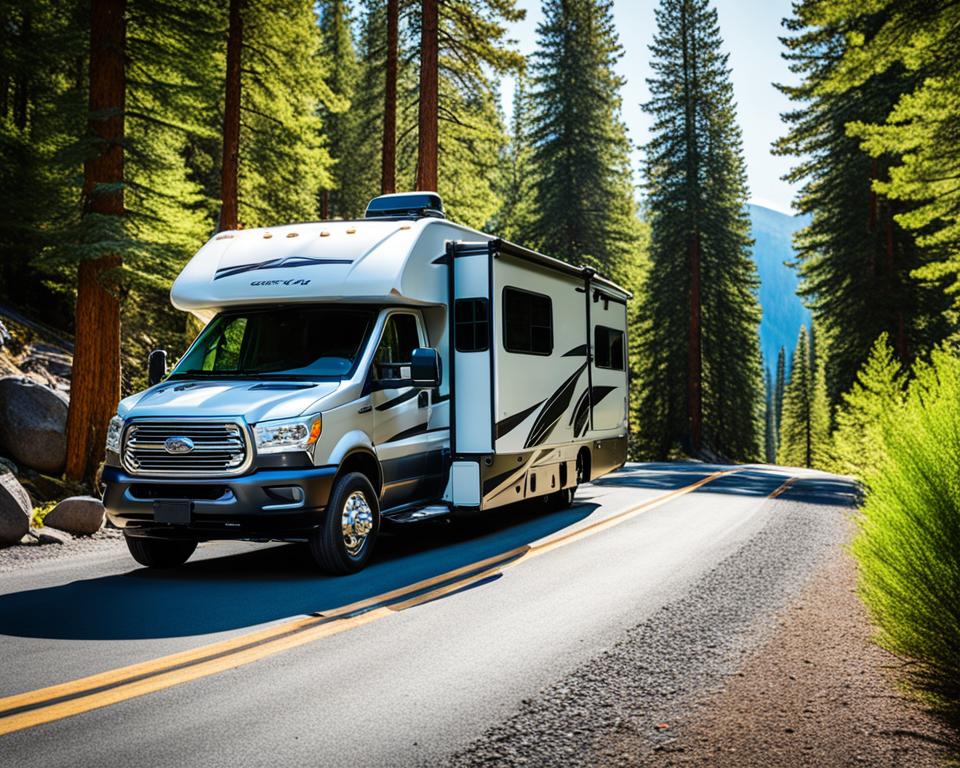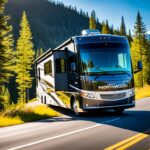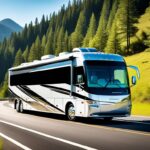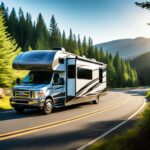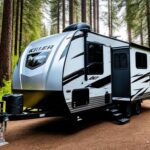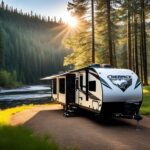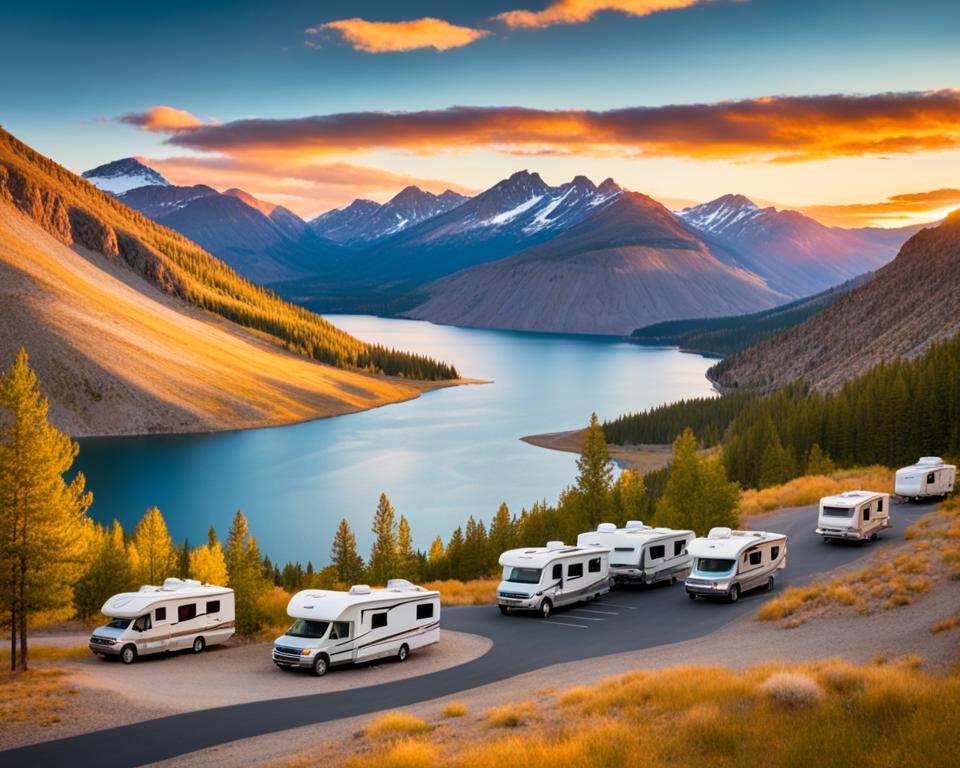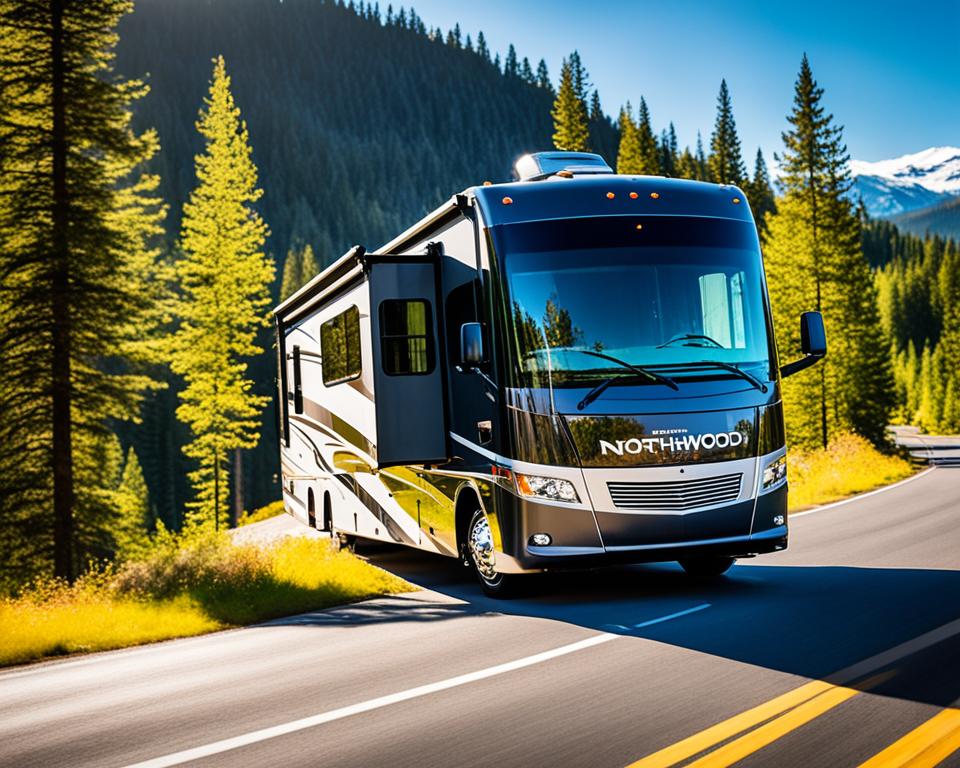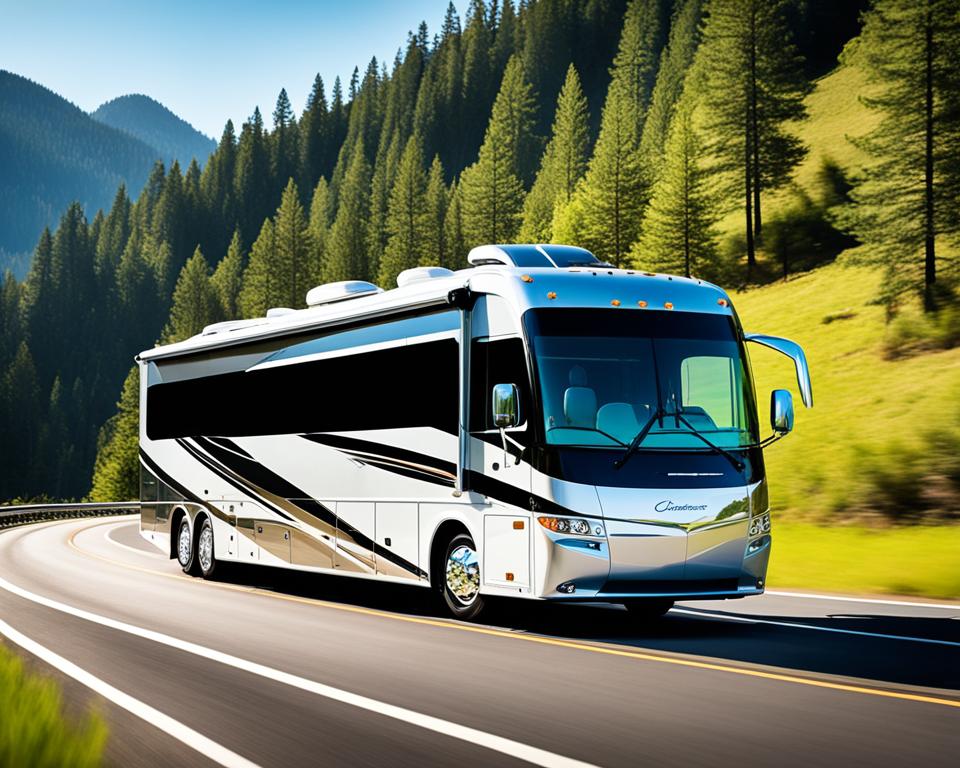RVing with a motorcycle carrier allows for the freedom and convenience of bringing your motorcycle along on your RV adventures. Whether you’re a seasoned motorcyclist or just starting out, having a motorcycle carrier for your RV can enhance your travels. In this article, we’ll explore essential tips and gear recommendations for safe and efficient motorcycle transportation while RVing.
Key Takeaways:
- Incorporating a motorcycle carrier in your RVing experience offers the convenience of having your motorcycle with you on your travels.
- Consider factors such as the type of RV, towing weight limitations, and compatibility when defining your motorcycle carrier requirements.
- Research different RV motorcycle carrier options from companies like Hydralift and Cruiserlift to find the best fit for your needs.
- Installing a motorcycle carrier on your RV may require modifications and professional assistance.
- Ensure safety and convenience by understanding the effects of the additional weight and following proper tie-down procedures.
Defining Your Requirements
Before you embark on your RVing adventure with a motorcycle carrier, it’s crucial to define your specific requirements. Consider the following factors to ensure a seamless and enjoyable travel experience:
1. Type of RV:
Take into account the type and size of your RV when choosing a motorcycle carrier. Different carriers are designed to accommodate specific RV models, so it’s essential to find one that fits your vehicle perfectly.
2. Towing Weight Limitations:
Check your RV’s towing capacity to determine the maximum weight your carrier and motorcycle can safely handle. Exceeding weight limitations can compromise safety and stability on the road.
3. Budget:
Establish a budget for your motorcycle carrier, considering both the initial purchase cost and any additional expenses for installation or modifications. Determine the value you are willing to invest in ensuring the safety and convenience of your motorcycle transport.
4. Compatibility with Motorhome:
Ensure that your chosen carrier is compatible with your motorhome. Some carriers may require specific attachments or modifications to be compatible, so it’s crucial to select one that seamlessly integrates with your RV.
5. Additional Vehicle Towing:
If you plan to tow another vehicle along with your motorcycle, consider whether you’ll need a carrier that allows for simultaneous towing. Some carriers are designed with multiple attachment points to accommodate a motorcycle and an additional vehicle.
6. Removability and Transferability:
Decide whether you need a carrier that is easily removable or transferable between RVs. This is particularly important if you switch between multiple motorhomes or if you prefer a carrier that can be removed when not in use.
7. Safety, Serviceability, and Value:
Prioritize safety features such as sturdy construction, secure tie-down attachments, and built-in anti-sway mechanisms. Consider the carrier’s serviceability, including ease of maintenance and availability of spare parts. Lastly, find a carrier that offers a balance of quality and affordability to maximize its value over time.
By considering these factors, you can define your requirements and choose a motorcycle carrier that suits your RVing needs perfectly.
Researching the Right Solution
Once you’ve defined your requirements for RVing with a motorcycle carrier, it’s essential to research the right solution that meets your needs. Various companies specialize in providing motorcycle transportation solutions for the RV industry, offering a range of options to choose from. Take the time to consider reputable brands like Hydralift and Cruiserlift, which offer different systems designed to securely lift and secure your motorcycle on the RV.
Evaluating the features, benefits, customer reviews, and price points of each solution will help you make an informed decision. Look for features such as ease of use, durability, and compatibility with your RV and motorcycle. Reading customer reviews can provide insights into the performance and reliability of the carriers. Remember to consider your budget and find a solution that offers the best value for your investment.
When researching, explore options specific to your RV type. If you’re RVing with a travel trailer, search for motorcycle carriers designed specifically for travel trailers. Similarly, if you’re using a camper van, look for motorcycle racks suitable for camper van installations. Finding a solution tailored to your specific RV setup can ensure a seamless and safe experience while traveling.
Tip: Don’t hesitate to reach out to fellow RVers or online communities for recommendations and firsthand experiences with different motorcycle carrier systems. Their insights can be valuable in helping you make an informed decision.
By thoroughly researching the right solution, you’ll be able to select a motorcycle carrier that provides the necessary security and ease of use for your RVing adventures.
Comparison Table: Motorcycle Carriers for RV
| Brand | Features | Customer Reviews | Price Range |
|---|---|---|---|
| Hydralift | Hydraulic lift system, secure tie-downs, customizable for different RV models | 4.5/5 (based on 100+ reviews) | $2,500 – $4,000 |
| Cruiserlift | Electric winch system, adjustable to fit various motorcycle sizes, easy installation | 4.3/5 (based on 80+ reviews) | $1,800 – $3,200 |
| Rack It | Aluminum construction, lightweight, compatible with travel trailers and camper vans | 4.2/5 (based on 60+ reviews) | $1,200 – $2,500 |
Table: A comparison of popular motorcycle carriers for RV, featuring Hydralift, Cruiserlift, and Rack It. The table highlights key features, customer reviews, and price ranges for each brand.
Installation and Removal Process
Installing a motorcycle carrier on your RV can provide a convenient and efficient way to transport your motorcycle while enjoying your RV adventures. However, the installation process may require some modifications and professional assistance to ensure proper functionality and safety.
First, it’s important to choose the right motorcycle carrier for your RV. Consider factors such as the type of RV you have, towing weight limitations, and compatibility with your motorhome. Depending on the specific carrier system you choose, you may need to remove and replace the tow hitch, weld additional support, or perform other installation tasks.
The installation process typically takes several hours, and it’s recommended to have a professional handle the installation to ensure it is done correctly. They have the experience and expertise to make the necessary adjustments and modifications to your RV, ensuring a secure and reliable motorcycle carrier installation.
Keep in mind that the installation process may involve additional costs beyond the purchase of the motorcycle carrier itself. It’s essential to factor in these costs and budget accordingly.
Additionally, it is important to understand that the installation and removal process may impact the resale value of your RV. Some modifications made during installation, such as welding additional support, may alter the original structure of the RV. If you plan to sell your RV in the future, it’s crucial to consider this potential impact.
Having professional assistance throughout the installation process can help to minimize any negative effects on the resale value of your RV.
| Pros | Cons |
|---|---|
| Professional installation ensures proper functionality and safety. | Installation may require modifications and incur additional costs. |
| Experienced professionals can make adjustments specific to your RV. | Modifications made during installation may impact the resale value of your RV. |
| Professional assistance minimizes the risk of errors during installation. | DIY installation may void the warranty on your RV. |
Expert Quote:
“Having a professional handle the installation of your motorcycle carrier can ensure that it is securely and safely attached to your RV. They have the knowledge and experience to make any necessary modifications and adjustments, giving you peace of mind during your travels.” – Jennifer Thompson, RVing Enthusiast
Now that you understand the importance of professional installation and the potential impact on your RV, you can confidently proceed with installing a motorcycle carrier for your RV. With a secure and reliable motorcycle carrier, you’ll be ready to hit the road and enjoy the freedom of RVing with your motorcycle.
Considerations for Safe and Convenient RV Travel
When embarking on RV travel with a motorcycle carrier, it’s crucial to prioritize safety and convenience. Taking into account the additional weight and positioning of the motorcycle can significantly impact your RV’s driving characteristics. To ensure a secure transportation, make use of adequate tie-down straps and conduct regular inspections to safeguard against any potential movements or shifts during travel.
Moreover, be mindful of length restrictions on U.S. roads and interstates. Adding a motorcycle carrier to your RV increases the overall length, potentially impacting maneuverability and navigation. It’s essential to familiarize yourself with these restrictions to ensure compliance and avoid any unnecessary inconveniences.
RV’ers traveling with a motorcycle carrier for their travel trailer or utilizing an RV motorcycle hitch should prioritize the following considerations:
- Secure Tie-downs: Invest in high-quality tie-down straps specifically designed for motorcycles to ensure a secure and stable attachment to your RV.
- Regular Inspections: Consistently check the tightness and condition of the tie-down straps, as well as the overall stability of the motorcycle carrier, to prevent any potential issues during travel.
- Weight Distribution: Properly distribute the weight of both the RV and the motorcycle carrier to maintain optimal stability and balance while on the road.
By considering these safety and convenience factors, you can enjoy worry-free RV travel with your motorcycle, knowing that you have taken the necessary precautions to ensure a smooth and secure journey.
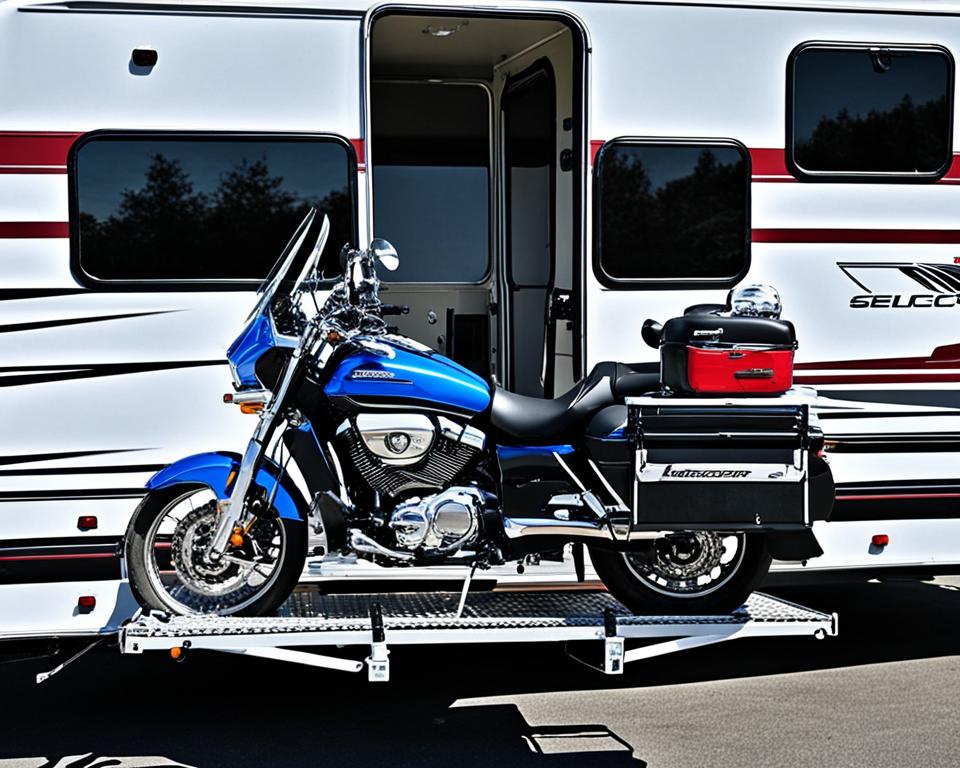
Warranty and Legal Considerations
Installing a motorcycle carrier for your RV can enhance your travel experience, but it’s important to consider warranty and legal aspects before making any modifications.
While each RV manufacturer may have specific warranty policies, many RV owners have reported no issues with warranty claims related to their motorcycle carriers. However, it’s always best to consult with the manufacturer to understand their policies and ensure compliance.
Additionally, it’s crucial to be aware of local laws and regulations when traveling with a motorcycle carrier. Different states may have specific requirements regarding custom modifications, lane splitting, and helmet usage. Familiarize yourself with these regulations to ensure you’re in compliance while on the road.
Consulting the Manufacturer
“I installed a motorcycle carrier on my RV and contacted the manufacturer to clarify any warranty concerns. They assured me that as long as the carrier was properly installed according to their guidelines, it wouldn’t void my warranty. It gave me peace of mind to know I could enjoy my RVing adventures with my motorcycle without worrying about warranty issues.” – RV Owner
Understanding Local Laws
“Before embarking on our RV trips, we thoroughly researched the legal requirements for each state we planned to visit. This included regulations for carrying motorcycles, helmet laws, and restrictions on custom modifications. Staying informed helped us ensure a hassle-free journey with our RV motorcycle carrier.” – RV Enthusiast
Benefits of Compliance
By adhering to warranty guidelines and local laws, you can enjoy the benefits and peace of mind that come with RVing with a motorcycle carrier. It allows you to fully utilize the carrier without any concerns about warranty claims or legal repercussions.
| Benefits of Compliance with Warranty and Legal Considerations |
|---|
| 1. Protects your RV’s warranty |
| 2. Ensures compliance with local laws and regulations |
| 3. Peace of mind while traveling with your motorcycle carrier |
Being mindful of warranty and legal considerations when installing a motorcycle carrier on your RV allows you to enjoy the freedom and convenience of traveling with your motorcycle while minimizing any potential issues. Stay informed, consult with the manufacturer, and research local laws to ensure a smooth and enjoyable journey.
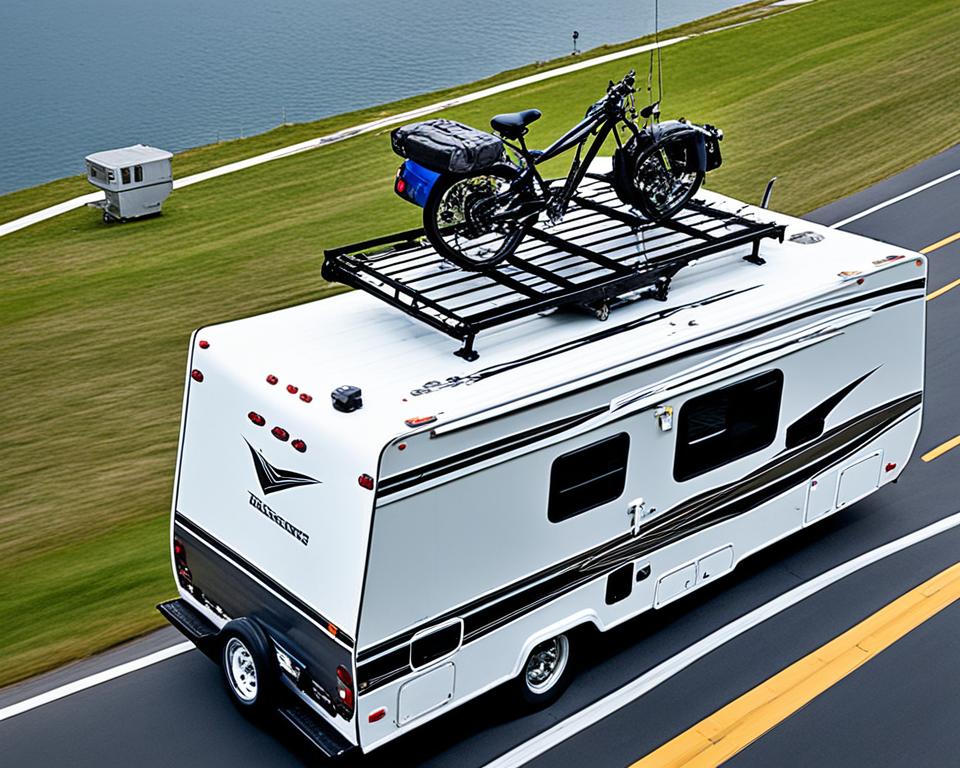
Choosing the Right Motorcycle Camping Gear
If you plan to incorporate motorcycle camping into your RV adventures, it’s important to choose the right gear. Consider factors such as the length of your trip, the type of camping accommodations you’ll encounter, and the resources available to you.
Invest in lightweight and space-saving gear that can withstand the demands of motorcycle travel. A suitable sleeping bag is essential for a comfortable night’s rest. Look for options that are compact, insulated, and suitable for the expected temperature range of your camping destinations.
Don’t forget to invest in a quality mattress pad to provide additional comfort and insulation. This can make a significant difference in ensuring a good night’s sleep, especially when camping on uneven terrain.
When it comes to your shelter, consider a tent or bivouac that is lightweight, easy to set up, and durable. Look for designs that offer ample space for you and your gear while still being compact enough to fit on your motorcycle.
| Essential Motorcycle Camping Gear | Recommended Brands |
|---|---|
| Sleeping Bag | Big Agnes, Therm-a-Rest, Marmot |
| Mattress Pad | Therm-a-Rest, Klymit, Nemo Equipment |
| Tent/Bivouac | MSR, Big Agnes, REI Co-op, Nemo Equipment |
| Cooking Equipment | Jetboil, MSR, Snow Peak, GSI Outdoors |
It’s important to be prepared for different weather conditions. Pack appropriate clothing that is versatile and can be layered for warmth. Look for riding gear that is waterproof and offers protection from the elements.
Don’t forget to bring essential tools for any necessary repairs or maintenance on your motorcycle. Additionally, pack a first aid kit and communication devices such as a reliable cell phone or two-way radio for emergencies.
Remember, space is limited when traveling on a motorcycle, so prioritize the gear that is necessary for your comfort and safety. Packing strategically will ensure that you have everything you need while keeping the weight balanced and manageable.
Being prepared with the right motorcycle camping gear will enhance your experience and allow you to fully enjoy the freedom of the open road and the beauty of the outdoors.
Preparing Your Motorcycle for Camping
Before embarking on a motorcycle camping trip, it’s crucial to ensure that your motorcycle is properly maintained and ready for the journey. Take the time to schedule a comprehensive maintenance check to address any potential issues and ensure a smooth and trouble-free adventure. Paying attention to your motorcycle’s maintenance needs will not only enhance your safety but also prolong the life of your bike.
Here are some essential steps to prepare your motorcycle for camping:
Schedule a Maintenance Check
Make an appointment with a trusted mechanic or perform a thorough maintenance check yourself if you have the necessary skills. Consider tasks such as:
- Oil Change: Replace the engine oil and oil filter to ensure optimal engine performance.
- Tire Inspection: Check the tire pressure and tread depth to ensure proper traction and stability.
- Brake Check: Inspect the brake pads, rotors, and brake fluid levels for safe stopping power.
- Fluid Levels: Verify that the coolant, transmission fluid, and other essential fluids are at the recommended levels.
- Electrical System: Check the battery, lights, and wiring to make sure everything is functioning correctly.
Verify State Laws and Regulations
Before you hit the road, familiarize yourself with the laws and regulations of the states you’ll be traveling through. Ensure that your motorcycle is compliant with all modifications and requirements, such as noise restrictions, helmet laws, and equipment regulations. Not adhering to these laws can result in fines or even legal issues.
Choose Appropriate Riding Gear
When planning for your motorcycle camping adventure, consider the climate and weather conditions you’ll encounter. Choose appropriate riding gear that provides protection and comfort. Opt for waterproof or water-resistant gear if there’s a chance of rain. Don’t forget to pack extra layers for varying temperatures. Quality riding gear is essential for your safety and enjoyment throughout the trip.
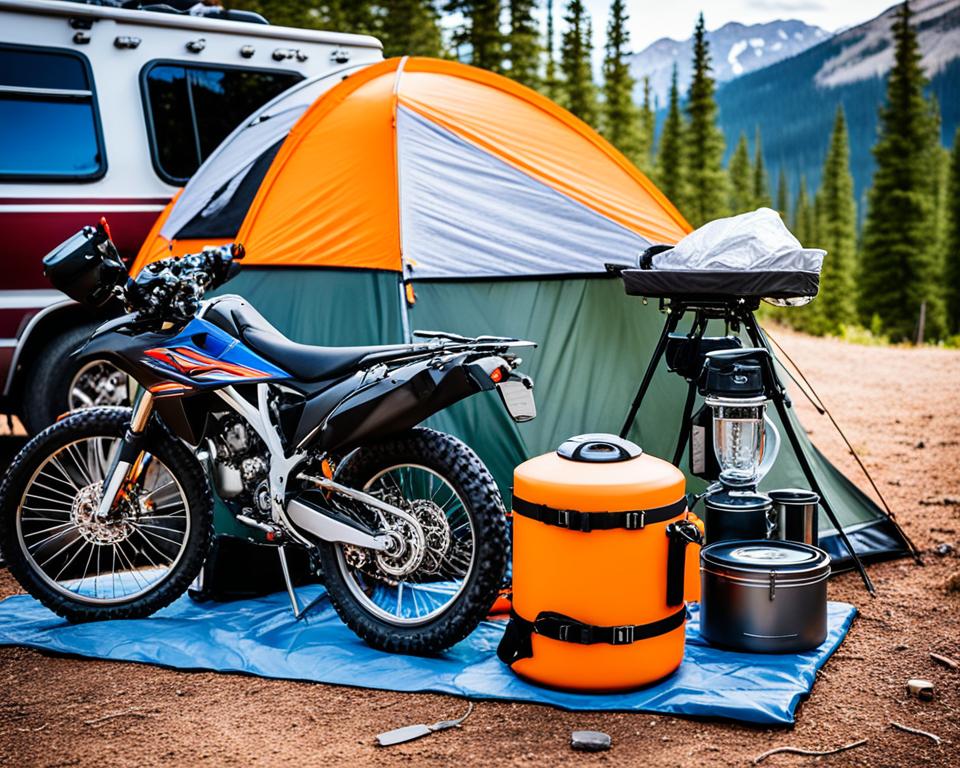
| Essential Motorcycle Camping Gear | Description |
|---|---|
| Sleeping Bag | A lightweight, compact sleeping bag designed for camping will keep you comfortable during nights under the stars. |
| Tent or Bivouac | Choose a tent or bivouac that suits the size of your camping party and provides suitable protection from the elements. |
| Portable Camping Stove | A compact propane or butane camping stove is ideal for cooking meals on the road. |
| Cooking Utensils | Pack a set of lightweight cooking utensils, including a pot, pan, spatula, and utensils for eating. |
| Camping Chair | A foldable camping chair allows you to relax and unwind at your campsite. |
| First Aid Kit | Keep a well-stocked first aid kit in case of any minor injuries or emergencies. |
| Tool Kit | Carry a basic toolkit to handle any minor repairs or maintenance tasks that may arise during your trip. |
By properly preparing your motorcycle and bringing the necessary gear, you can embark on a motorcycle camping adventure with confidence and peace of mind. Enjoy the freedom of the open road and the beauty of the great outdoors as you explore new destinations on two wheels.
Packing Strategies for Motorcycle Camping
Packing for motorcycle camping requires strategic planning to optimize space and weight distribution. To ensure a smooth and enjoyable trip, consider the following strategies:
- Utilize Saddlebags, Trunks, and Backpacks: These storage options are ideal for storing gear and distributing weight evenly on the motorcycle. Saddlebags can be attached to the sides of the motorcycle, while trunks provide additional storage at the rear. Backpacks can be used to carry smaller items that you may need quick access to.
- Pack Essentials Last: As you arrange your gear, pack the essentials last to ensure they are easily accessible when needed. This includes items like your sleeping bag, tent, cooking equipment, and toiletries.
- Use Packing Cubes or Bags: Organize and compress your clothing and equipment using packing cubes or bags. This helps maximize space and keeps items well-organized.
- Prioritize Necessities: When deciding what to pack, consider the size and weight of each item. Prioritize necessities over non-essential items to ensure you have enough space for important gear.
- Leave Room for Additional Purchases: If you plan on stopping at local stores or attractions during your trip, leave some empty space in your storage compartments to accommodate any additional purchases.
- Bring Water Bottles: Staying hydrated is essential when camping, so be sure to bring water bottles that are easily accessible during your ride.
- Include Personal Items: Don’t forget to pack personal items like toiletries, medication, and any other items specific to your needs.
By following these packing strategies, you can ensure that you have all the necessary gear for a successful motorcycle camping trip. Remember to plan ahead, prioritize essentials, and utilize storage options effectively for a comfortable and enjoyable adventure on the open road.
Motorcycle Camping Tips and Tricks
Make the most of your motorcycle camping experience with these tips and tricks. Whether you’re a seasoned camper or just starting out, these suggestions will help ensure a successful and enjoyable motorcycle camping adventure.
Stay Organized: Create checklists to keep track of essential items and gear. Prioritize packing lightweight and space-saving camping equipment and clothing. Keep frequently used items easily accessible for convenience during your trip.
Plan Ahead: Research and plan your routes and accommodations in advance, especially during peak camping seasons. Make reservations at motorcycle-friendly campgrounds or those that offer amenities catering to motorcycle campers.
Follow Regulations: Stay mindful of local regulations regarding camping and motorcycle usage. Familiarize yourself with any specific rules or restrictions that apply to the areas you’ll be visiting. Adhere to safe riding techniques and always wear appropriate protective gear.
Be Prepared: Pack essential motorcycle camping gear such as a reliable tent or bivouac, a lightweight sleeping bag, and cooking equipment. Carry a comprehensive first aid kit, tools for basic repairs, and communication devices in case of emergencies.
Embrace the Adventure: Motorcycle camping offers a unique and exhilarating experience of exploring on two wheels. Enjoy the freedom and the scenic beauty that comes with camping in different locations. Connect with nature and fellow travelers along the way.
“Motorcycle camping allows you to fully immerse yourself in the journey, combining the joy of riding with the serenity of the great outdoors.” – Motorcycle Camping Enthusiast
Recommended Camping Gear Checklist:
| Essential Gear | Camping Equipment | Clothing and Personal Items |
|---|---|---|
| Tent or bivouac | Sleeping bag | Riding gear (helmet, gloves, jacket) |
| Sleeping pad or air mattress | Cooking stove and utensils | Rain gear |
| Camp chair or stool | Camping lantern or headlamp | Spare clothes |
| Portable campfire or grill | Water filtration system | Personal hygiene items |
| Multi-tool or pocket knife | Cooler for food and drinks | Medications |
Remember to pack lightweight and compact gear that suits your needs and the duration of your camping trip. Prioritize essentials and consider the size and weight of each item to optimize space on your motorcycle. With the right gear and a spirit of adventure, motorcycle camping will provide unforgettable experiences on the open road.
Gear Recommendations for Long-Term RVing
For RVers who plan to incorporate motorcycle travel into their long-term RVing lifestyle, it’s important to invest in quality gear that can withstand the rigors of the road. To ensure a smooth and secure journey, consider the following gear recommendations:
1. Durable Motorcycle Carriers
Choose motorcycle carriers specifically designed for RVs, such as hydraulic lift systems or winch systems. These carriers offer high capacity and durability, allowing you to safely transport your motorcycle on long-term RV trips. Look for carriers that are known for their serviceability and value, as they will provide long-lasting reliability.
2. Compatibility and Consultation
Ensure that the motorcycle carrier you select is compatible with your RV and tow vehicle. Double-check weight limits, hitch compatibility, and installation requirements to avoid any issues while on the road. It’s also beneficial to consult with experienced RVers or reputable dealers for their recommendations and insights into the best gear for your specific setup.
3. Safety and Convenience
Prioritize safety and convenience when choosing gear for long-term RVing with a motorcycle carrier. Look for features such as secure tie-down straps, adjustable heights, and ease of loading and unloading. Consider carriers with added features like locking mechanisms or integrated ramps for added convenience and peace of mind.
4. Reliable Brands
Opt for gear from reliable manufacturers that have established a reputation for producing high-quality motorcycle carriers for RVs. Brands like Hydralift, Cruiserlift, and VersaHaul are known for their reliable and durable products. Conduct thorough research, read customer reviews, and evaluate warranties to ensure you invest in gear that meets your long-term RVing needs.
| Brand | Features | Capacity | Price Range |
|---|---|---|---|
| Hydralift | Hydraulic lift system, adjustable heights, locking mechanism | Up to 1,000 lbs | $2,000 – $4,000 |
| Cruiserlift | Electric winch system, removable sidewalls, integrated ramp | Up to 1,000 lbs | $1,500 – $2,500 |
| VersaHaul | Versatile hitch-mounted carrier, adjustable track width, anti-tilt device | Up to 600 lbs | $200 – $600 |
Note: Prices may vary based on specific features and additional accessories.
Investing in quality gear for long-term RVing with a motorcycle carrier ensures that you can fully enjoy the freedom and flexibility of exploring on two wheels. Prioritize safety, compatibility, and reliability when making your gear selections to create memorable and worry-free adventures.
Conclusion
RVing with a motorcycle carrier opens up a world of adventure and freedom for motorcyclists. Whether you’re exploring the scenic countryside or hitting the open road, the combination of RVing and motorcycle travel can create exciting and unforgettable experiences.
To ensure a successful journey, it’s crucial to define your requirements and research the right gear. Consider your RV’s towing capabilities, budget, and compatibility with a motorcycle carrier. Look for reputable brands like Hydralift and Cruiserlift, which offer reliable and secure systems for transporting motorcycles on RVs.
Once you’ve installed the motorcycle carrier, focus on safety and convenience. Regularly maintain your motorcycle to ensure it’s in top condition. When packing for motorcycle camping, be strategic in selecting lightweight and space-saving gear. Organize your belongings and prioritize necessities to optimize space and weight distribution.
By following these tips and tricks, you can embark on an incredible RVing adventure with your motorcycle. From exploring breathtaking landscapes to enjoying the thrill of the open road, RVing with a motorcycle carrier offers endless possibilities for both motorcyclists and RV enthusiasts alike.
FAQ
What are the benefits of RVing with a motorcycle carrier?
RVing with a motorcycle carrier allows for the freedom and convenience of bringing your motorcycle along on your RV adventures.
How do I define my requirements for a motorcycle carrier?
Consider factors such as the type of RV you have, towing weight limitations, budget, and compatibility with your motorhome.
How do I research the right solution for my RV motorcycle carrier?
Look into companies like Hydralift and Cruiserlift, and evaluate their features, benefits, customer reviews, and price points.
What should I consider during the installation and removal process?
Understand the modifications and professional assistance required, as well as the impact on the resale value of your RV.
What safety and convenience measures should I consider when using a motorcycle carrier for RV travel?
Consider the effects of the additional weight and position of the motorcycle on your RV’s driving characteristics, and ensure you have adequate tie-down straps.
Will installing a motorcycle carrier void my RV’s warranty?
While it’s important to check with the manufacturer, many RV owners have reported no issues with warranty claims related to their motorcycle carriers.
What gear should I choose for motorcycle camping?
Consider factors such as the length of your trip, the type of camping accommodations, and the resources available to you.
How do I prepare my motorcycle for camping?
Schedule a maintenance check, ensure compliance with laws and regulations, and pack appropriate riding gear for the climate and weather conditions.
What are some packing strategies for motorcycle camping?
Utilize saddlebags, trunks, and backpacks to store gear, use packing cubes or bags to organize and compress clothing and equipment, and prioritize necessities over non-essentials.
What tips and tricks should I know for motorcycle camping?
Stay organized with checklists, plan routes and accommodations in advance, utilize campgrounds and amenities for motorcycle campers, and practice safe riding techniques.
What are some gear recommendations for long-term RVing with a motorcycle carrier?
Consider durable motorcycle carriers specifically designed for RVs, such as hydraulic lift systems or winch systems, that offer high capacity, serviceability, and value.

